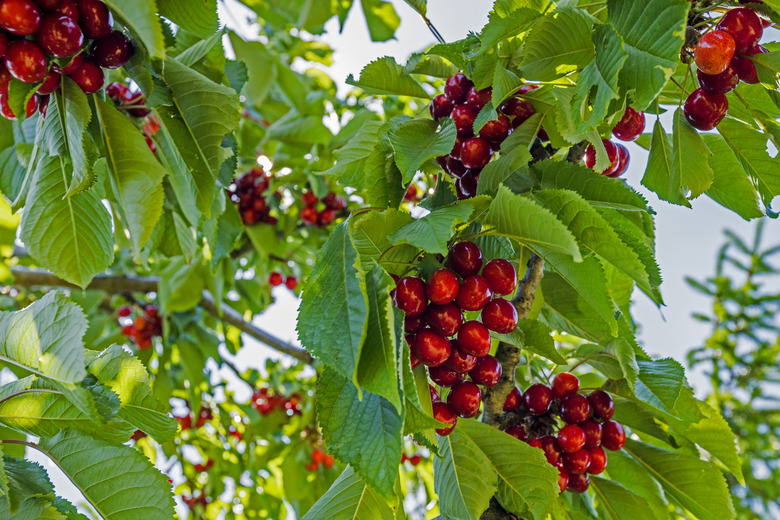Wild Black Cherry Tree Identification
Wild black cherry (Prunus serotina) grows from Maine to Florida and westward into the Great Plains. The wild black cherry tree takes its name from the color of both its edible fruit and its bark. Both of these features of the black cherry tree, as well as other aspects such as its foliage, size and shape, make it easier to identify.
Wild Cherry Tree Size
The average wild black cherry tree has a trunk diameter of about 2 feet. The tallest trees grow to heights of 80 to 90 feet, but the average black cherry is within the 50 to 60 foot range in terms of its height. The spread of wild cherry tree branches vary from 35 to 50 feet in width on mature specimens. Wild black cherry trees tend to have an oval or pyramidal shape, with the ends of the branches drooping downward. Sweet and tart cherries grown in orchards or at home are usually shorter than wild black cherry trees, usually 20 to 35 feet tall.
- Wild black cherry (Prunus serotina) grows from Maine to Florida and westward into the Great Plains.
- The tallest trees grow to heights of 80 to 90 feet, but the average black cherry is within the 50 to 60 foot range in terms of its height.
Foliage Appearance
The black cherry leaf size is usually between 2 and 6 inches long with a long, pointed tip and tapered base. You can also identify the leaves by the fine serrations along the edges. Leaves develop early in spring, usually before those of most surrounding trees, growing on alternating sides of the branch. Fall colors range from yellow-green to yellow, red and orange.
Flowers and Fruit
The flowers and fruit of wild black cherry are easily recognizable. The flowers are white with five petals and grow in a drooping cluster as long as your fingers. These clusters, called racemes, emerge in the middle of the spring and produce a fragrant aroma. Bees and other bugs flock to them.
- The black cherry leaf size is usually between 2 and 6 inches long with a long, pointed tip and tapered base.
The fruit is one-third of an inch wide, about the size of a large pea, and starts out red before turning black-purple by late summer or early autumn. The more mature fruit is juicy and softer than the immature types. Although bitter, it is not quite as tart as when it is not ripe.
Bark Traits
The bark on the young wild black cherry tree is smooth, dark gray in color and has lenticles, which are raised pores, throughout. The bark then begins to turn flaky as the black cherry ages, until it is a dark shade of gray-silver to nearly black. The texture and color of the bark is sometimes compared to black cornflakes. This dark bark shows up vividly in winter, when the majority of trees in the forest have no leaves.
- The fruit is one-third of an inch wide, about the size of a large pea, and starts out red before turning black-purple by late summer or early autumn.
- The bark on the young wild black cherry tree is smooth, dark gray in color and has lenticles, which are raised pores, throughout.
Common Locations
Wild black cherry trees often grow in open woodlots, fields and along roadsides. Black cherry trees prefer deep, damp, fertile ground, but the species can grow in almost any conditions. You may find many black cherry trees growing together, as the seeds the fruits contain fall to the ground to grow new seedlings. You will often find tent caterpillars and their large wispy whitish homes in the branches of a wild black cherry.
You can spot a wild cherry tree based on its bark, flowers, leaves and fruit. Compared to a tart or sweet cherry tree, wild cherry trees tend to be taller and grow in areas outside of orchards or backyards.
